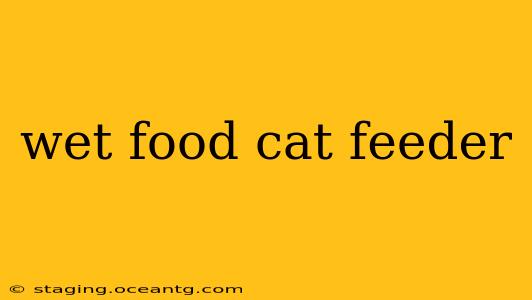Choosing the right wet food cat feeder can significantly impact your feline friend's health and happiness. Unlike dry kibble, wet food requires special consideration to prevent spoilage and ensure your cat enjoys their meals. This comprehensive guide explores various wet food cat feeders, addressing common concerns and helping you select the perfect one for your furry companion.
What are the Benefits of Using a Wet Food Cat Feeder?
Using a dedicated wet food cat feeder offers several advantages:
-
Preserves Freshness: Many feeders are designed to keep wet food cool and prevent it from spoiling as quickly as it would in a standard bowl. This is especially important in warmer climates or if your cat doesn't finish their entire meal at once.
-
Portion Control: Feeders can help with portion control, which is crucial for maintaining a healthy weight for your cat. This is particularly beneficial if you have a cat prone to overeating.
-
Slows Down Eating: Some feeders are designed to encourage slower eating, preventing gulping and potential digestive issues. This is especially important for cats with sensitive stomachs or those who tend to eat too quickly.
-
Reduces Mess: Certain feeders are designed to minimize spills and messes, keeping your kitchen cleaner.
-
Improved Hygiene: Some models make cleaning easier, preventing the buildup of bacteria that can cause illness.
What Types of Wet Food Cat Feeders are Available?
Several types of wet food cat feeders cater to different needs and preferences:
-
Refrigerated Feeders: These are ideal for keeping wet food cool for extended periods, preventing spoilage. Some even have temperature controls for optimal freshness.
-
Slow Feeders: Designed with puzzles or compartments to slow down your cat's eating pace. This aids digestion and can be beneficial for cats with eating-related anxiety.
-
Automatic Feeders (for wet food): While primarily designed for dry food, some automatic feeders can also accommodate wet food, offering scheduled feeding options for busy owners. However, be sure to choose one specifically designed for wet food, to avoid jams and spills. You'll also need to clean it frequently.
-
Standard Elevated Feeders: Raising the food bowl can alleviate strain on your cat's neck and joints during eating. While not specifically designed for wet food, they can be used in conjunction with a smaller, easily cleaned bowl inside.
How Do I Choose the Right Wet Food Cat Feeder?
Choosing the best wet food cat feeder depends on your cat's individual needs and your lifestyle:
-
Consider your cat's eating habits: Does your cat eat quickly or slowly? Does your cat have any digestive sensitivities? A slow feeder might be beneficial for quick eaters, while a refrigerated feeder is ideal for cats who don't finish their meal in one sitting.
-
Think about your lifestyle: Do you need a feeder that offers automated feeding? Or are you happy to manually fill a bowl? Consider the time and effort you're willing to invest in maintaining your cat's food.
-
Look at the feeder's materials: Choose a feeder that's made from durable, easy-to-clean materials like stainless steel or BPA-free plastic.
-
Check the size and capacity: Select a feeder that is appropriately sized for your cat's food intake and easy to fill and clean.
What are the Potential Drawbacks of Wet Food Feeders?
While wet food feeders offer numerous advantages, some potential drawbacks exist:
-
Cost: Refrigerated and automatic feeders can be more expensive than standard bowls.
-
Maintenance: Some feeders require more frequent cleaning than others. Automatic feeders, in particular, need regular cleaning to prevent bacteria buildup and malfunction.
-
Not all feeders are suitable for all types of wet food: Some feeders might not be compatible with all types of wet food textures or packaging.
How Often Should I Clean My Wet Food Cat Feeder?
Cleaning your wet food cat feeder regularly is vital for maintaining hygiene and preventing bacterial growth. Aim to clean it at least once daily, especially if your cat doesn't finish the entire meal. Thoroughly wash the feeder with warm soapy water and rinse it well before refilling. Allow it to air dry completely before adding fresh food.
Can I Use a Regular Food Bowl for Wet Food?
While you can use a regular food bowl, a dedicated wet food feeder offers significant advantages regarding freshness, portion control, and hygiene. A standard bowl will not prevent spoilage of wet food as efficiently.
Are There Any Safety Concerns to Consider?
Always ensure the wet food cat feeder is made from non-toxic materials and is sturdy enough to prevent tipping or accidental injury to your cat. Regularly inspect the feeder for any damage or signs of wear and tear. Avoid feeders with small parts that could present a choking hazard.
Choosing the right wet food cat feeder is an investment in your cat's health and well-being. By carefully considering your cat's individual needs and your lifestyle, you can find the perfect feeder to ensure your feline companion enjoys their meals while maintaining optimal hygiene and freshness.
